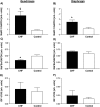Skeletal muscle alterations in chronic heart failure: differential effects on quadriceps and diaphragm
- PMID: 26674018
- PMCID: PMC4670747
- DOI: 10.1002/jcsm.12034
Skeletal muscle alterations in chronic heart failure: differential effects on quadriceps and diaphragm
Abstract
Background: Chronic heart failure (CHF) results in limb and respiratory muscle weakness, which contributes to exercise intolerance and increased morbidity and mortality, yet the molecular mechanisms remain poorly understood. Therefore, we aimed to compare parameters of antioxidative capacity, energy metabolism, and catabolic/anabolic balance in diaphragm and quadriceps muscle in an animal model of CHF.
Methods: Ligation of the left anterior descending coronary artery (n = 13) or sham operation (n = 11) was performed on Wistar Kyoto rats. After 12 weeks, echocardiography and invasive determination of maximal rates of left ventricular (LV) pressure change were performed. Antioxidative and metabolic enzyme activities and expression of catabolic/anabolic markers were assessed in quadriceps and diaphragm muscle.
Results: Ligated rats developed CHF (i.e. severe LV dilatation, reduced LV ejection fraction, and impaired maximal rates of LV pressure change; P < 0.001). There was a divergent response for antioxidant enzymes between the diaphragm and quadriceps in CHF rats, with glutathione peroxidase and manganese superoxide dismutase activity increased in the diaphragm but reduced in the quadriceps relative to shams (P < 0.01). Metabolic enzymes were unaltered in the diaphragm, but cytochrome c oxidase activity (P < 0.01) decreased and lactate dehydrogenase activity (P < 0.05) increased in the quadriceps of CHF animals. Protein expression of the E3 ligase muscle ring finger 1 and proteasome activity were increased (P < 0.05) in both the diaphragm and quadriceps in CHF rats compared with shams.
Conclusion: Chronic heart failure induced divergent antioxidative and metabolic but similar catabolic responses between the diaphragm and quadriceps. Despite the quadriceps demonstrating significant impairments in CHF, apparent beneficial adaptations of an increased antioxidative capacity were induced in the diaphragm. Nevertheless, muscle ring finger 1 and proteasome activity (markers of protein degradation) were elevated and oxidative enzyme activity failed to increase in the diaphragm of CHF rats, which suggest that a myopathy is likely present in respiratory muscle in CHF, despite its constant activation.
Keywords: Antioxidative enzymes; CHF; Congestive heart failure; MuRF-1.
Figures





Similar articles
-
Pharmacological targeting of mitochondrial reactive oxygen species counteracts diaphragm weakness in chronic heart failure.J Appl Physiol (1985). 2016 Apr 1;120(7):733-42. doi: 10.1152/japplphysiol.00822.2015. Epub 2016 Feb 4. J Appl Physiol (1985). 2016. PMID: 26846552 Free PMC article.
-
Therapeutic Approaches in Mitochondrial Dysfunction, Proteolysis, and Structural Alterations of Diaphragm and Gastrocnemius in Rats With Chronic Heart Failure.J Cell Physiol. 2016 Jul;231(7):1495-513. doi: 10.1002/jcp.25241. Epub 2015 Nov 20. J Cell Physiol. 2016. PMID: 26530247
-
Differential effects of right and left heart failure on skeletal muscle in rats.J Cachexia Sarcopenia Muscle. 2020 Dec;11(6):1830-1849. doi: 10.1002/jcsm.12612. Epub 2020 Sep 28. J Cachexia Sarcopenia Muscle. 2020. PMID: 32985798 Free PMC article.
-
Clinical aspects of left ventricular diastolic function assessed by Doppler echocardiography following acute myocardial infarction.Dan Med Bull. 2001 Nov;48(4):199-210. Dan Med Bull. 2001. PMID: 11767125 Review.
-
Comparative assessment of the quadriceps and the diaphragm in patients with COPD.J Appl Physiol (1985). 2009 Sep;107(3):952-61. doi: 10.1152/japplphysiol.00194.2009. Epub 2009 Apr 9. J Appl Physiol (1985). 2009. PMID: 19359618 Review.
Cited by
-
Curcumin improves exercise performance of mice with coronary artery ligation-induced HFrEF: Nrf2 and antioxidant mechanisms in skeletal muscle.J Appl Physiol (1985). 2019 Feb 1;126(2):477-486. doi: 10.1152/japplphysiol.00654.2018. Epub 2018 Nov 21. J Appl Physiol (1985). 2019. PMID: 30462567 Free PMC article.
-
Muscle wasting in young patients with dilated cardiomyopathy.J Cachexia Sarcopenia Muscle. 2017 Aug;8(4):542-548. doi: 10.1002/jcsm.12193. Epub 2017 Mar 1. J Cachexia Sarcopenia Muscle. 2017. PMID: 28251827 Free PMC article.
-
Relationship between skeletal muscle mass and cardiac function during exercise in community-dwelling older adults.ESC Heart Fail. 2017 Nov;4(4):409-416. doi: 10.1002/ehf2.12158. Epub 2017 Apr 10. ESC Heart Fail. 2017. PMID: 29154420 Free PMC article.
-
Prediction of Loss of Muscle Mass in Sarcopenia Using Ultrasonic Diaphragm Excursion.Contrast Media Mol Imaging. 2021 Dec 6;2021:4754705. doi: 10.1155/2021/4754705. eCollection 2021. Contrast Media Mol Imaging. 2021. PMID: 34949970 Free PMC article.
-
Small-molecule-mediated chemical knock-down of MuRF1/MuRF2 and attenuation of diaphragm dysfunction in chronic heart failure.J Cachexia Sarcopenia Muscle. 2019 Oct;10(5):1102-1115. doi: 10.1002/jcsm.12448. Epub 2019 May 29. J Cachexia Sarcopenia Muscle. 2019. PMID: 31140761 Free PMC article.
References
-
- Adams V, Döring C, Schuler G. Impact of physical exercise on alterations in the skeletal muscle in patients with chronic heart failure. Front Biosci. 2008;13:302–11. - PubMed
-
- Adams V, Linke A, Kränkel N, Erbs S, Gielen S, Möbius-Winkler S, et al. Impact of regular physical activity on the NAD(P)H oxidase and angiotensin receptor system in patients with coronary artery disease. Circulation. 2005;111:555–62. - PubMed
-
- Adams V, Linke A, Wisloff U, Doring C, Erbs S, Krankel N, et al. Myocardial expression of MuRF-1 and MAFbx after induction of chronic heart failure: effect on myocardial contractility. Cardiovasc Res. 2007;73:120–9. - PubMed
-
- Adams V, Mangner N, Gasch A, Krohne C, Gielen S, Hirner S, et al. Induction of MuRF1 is essential for TNF-[alpha]-induced loss of muscle function in mice. J Mol Biol. 2008;384:48–59. - PubMed
-
- Anker SD, Negassa A, Coats AJ, Afzal R, Poole-Wilson PA, Cohn JN, et al. Prognostic importance of weight loss in chronic heart failure and the effect of treatment with angiotensin-converting-enzyme inhibitors: an observational study. Lancet. 2003;361:1077–83. - PubMed
LinkOut - more resources
Full Text Sources
Other Literature Sources

